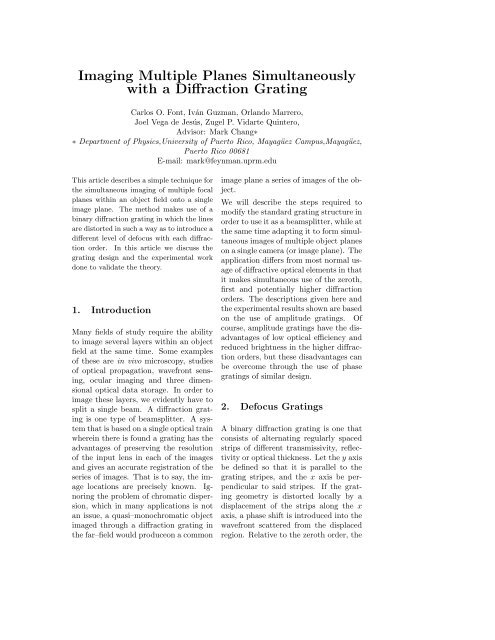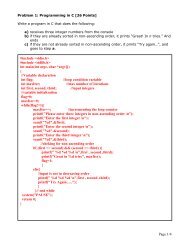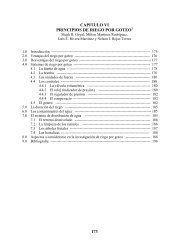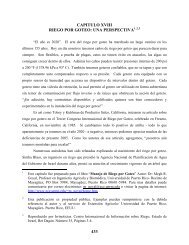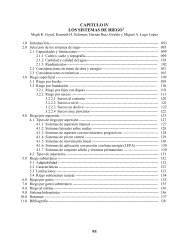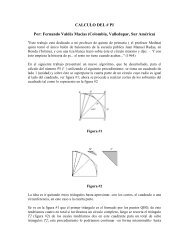Imaging Multiple Planes Simultaneously with a Diffraction Grating
Imaging Multiple Planes Simultaneously with a Diffraction Grating
Imaging Multiple Planes Simultaneously with a Diffraction Grating
You also want an ePaper? Increase the reach of your titles
YUMPU automatically turns print PDFs into web optimized ePapers that Google loves.
<strong>Imaging</strong> <strong>Multiple</strong> <strong>Planes</strong> <strong>Simultaneously</strong><br />
<strong>with</strong> a <strong>Diffraction</strong> <strong>Grating</strong><br />
Carlos O. Font, Iván Guzman, Orlando Marrero,<br />
Joel Vega de Jesús, Zugel P. Vidarte Quintero,<br />
Advisor: Mark Chang∗<br />
∗ Department of Physics,University of Puerto Rico, Mayagüez Campus,Mayagüez,<br />
Puerto Rico 00681<br />
E-mail: mark@feynman.uprm.edu<br />
This article describes a simple technique for<br />
the simultaneous imaging of multiple focal<br />
planes <strong>with</strong>in an object field onto a single<br />
image plane. The method makes use of a<br />
binary diffraction grating in which the lines<br />
are distorted in such a way as to introduce a<br />
different level of defocus <strong>with</strong> each diffraction<br />
order. In this article we discuss the<br />
grating design and the experimental work<br />
done to validate the theory.<br />
1. Introduction<br />
Many fields of study require the ability<br />
to image several layers <strong>with</strong>in an object<br />
field at the same time. Some examples<br />
of these are in vivo microscopy, studies<br />
of optical propagation, wavefront sensing,<br />
ocular imaging and three dimensional<br />
optical data storage. In order to<br />
image these layers, we evidently have to<br />
split a single beam. A diffraction grating<br />
is one type of beamsplitter. A system<br />
that is based on a single optical train<br />
wherein there is found a grating has the<br />
advantages of preserving the resolution<br />
of the input lens in each of the images<br />
and gives an accurate registration of the<br />
series of images. That is to say, the image<br />
locations are precisely known. Ignoring<br />
the problem of chromatic dispersion,<br />
which in many applications is not<br />
an issue, a quasi–monochromatic object<br />
imaged through a diffraction grating in<br />
the far–field would produceon a common<br />
image plane a series of images of the object.<br />
We will describe the steps required to<br />
modify the standard grating structure in<br />
order to use it as a beamsplitter, while at<br />
the same time adapting it to form simultaneous<br />
images of multiple object planes<br />
on a single camera (or image plane). The<br />
application differs from most normal usage<br />
of diffractive optical elements in that<br />
it makes simultaneous use of the zeroth,<br />
first and potentially higher diffraction<br />
orders. The descriptions given here and<br />
the experimental results shown are based<br />
on the use of amplitude gratings. Of<br />
course, amplitude gratings have the disadvantages<br />
of low optical efficiency and<br />
reduced brightness in the higher diffraction<br />
orders, but these disadvantages can<br />
be overcome through the use of phase<br />
gratings of similar design.<br />
2. Defocus <strong>Grating</strong>s<br />
A binary diffraction grating is one that<br />
consists of alternating regularly spaced<br />
strips of different transmissivity, reflectivity<br />
or optical thickness. Let the y axis<br />
be defined so that it is parallel to the<br />
grating stripes, and the x axis be perpendicular<br />
to said stripes. If the grating<br />
geometry is distorted locally by a<br />
displacement of the strips along the x<br />
axis, a phase shift is introduced into the<br />
wavefront scattered from the displaced<br />
region. Relative to the zeroth order, the
local phase shift φ m (x, y) is dependent<br />
on the amount of the local grating shift<br />
through<br />
φ m (x, y) = 2πm∆ x(x, y)<br />
d<br />
[1]<br />
where d is the grating period, m is the<br />
diffraction order into which the wavefront<br />
is scattered and ∆ x is the displacement<br />
of the grating strips relative to<br />
their undistorted positions.<br />
All non zeroth orders therefore undergo<br />
a phase shift that is linearly dependent<br />
on the grating displacement. This phase<br />
shift is equal in magnitude but opposite<br />
in sign to the positive and negative orders<br />
of the same coefficient. This principle<br />
is sometimes known as the detour<br />
phase effect and has been used to encode<br />
diffractive optics elements.<br />
What is of interest is the ability to generate<br />
different levels of defocus in the wavefronts<br />
that are diffracted into each order.<br />
This may be done by applying phase delays<br />
that modify the wavefront curvature.<br />
How might the required phase delays<br />
be calculated? In general, regular<br />
diffractive elements (gratings) produce<br />
regular sets of images along the length<br />
of the optical axis of the system. This<br />
can be taken to mean that, for the zeroth<br />
diffracted order say, the image of a point<br />
object is a line that extends along the<br />
optical axis. The simplest phase profile<br />
of a wavefront that generates this type of<br />
image is spherical. So consider the phase<br />
profile of a diffractive element that forms<br />
a spherical wavefront,<br />
φ(r) = 2π λ<br />
(f − √ f 2 − r 2 )<br />
[2]<br />
where f is the effective focal length of<br />
the element and r is a general radial coordinate.<br />
This is justified in Figure (1).<br />
Equation (2) may be expanded to give<br />
( r<br />
2<br />
2f + r4<br />
8f 3 +<br />
)<br />
r6<br />
16f 5 + . . .<br />
φ(r) = 2π λ<br />
[3]<br />
The above expansion is easily simplified<br />
if the paraxial case is considered. Hence<br />
we only need the first term of Equation<br />
(3). Higher order terms are valid, but<br />
will not be considered in detail. In the<br />
paraxial case defocus is described by a<br />
phase shift which varies as the square of<br />
the distance from the optical axis, relative<br />
to the in–focus system. A simple<br />
way to encode this defocus into a grating<br />
is to first consider a standard line grating<br />
in a circular pupil. See Figure (1). By<br />
considering a grating <strong>with</strong> the quadratic<br />
phase shift encoded into it as a series of<br />
rows, where each row is a normal grating<br />
translated in the x direction, it is possible<br />
to find a relation for the local phase<br />
shift in terms of the offset ∆ x .<br />
This defocus offset can be written as<br />
( )<br />
∆ x W20<br />
= ± r 2<br />
d<br />
λ<br />
( )<br />
W20 (x 2 + y 2 )<br />
= ±<br />
λ R 2 [4]<br />
Here r 2 = (x 2 + y 2 )/R 2 where R, the radius<br />
of the full aperture, is the normalisation<br />
constant. The amount of defocus<br />
is contained in the standard coefficient of<br />
defocus W 20 , the extra path length introduced<br />
at the edge of the aperture, which<br />
in this case is shown for the wavefront<br />
diffracted into the ±1 orders. The phase<br />
change φ m of the wavefronts diffracted<br />
into each order is then given by<br />
φ m (x, y) = m 2π W 20<br />
λ R 2 (x2 + y 2 ) [5]<br />
What form do the grating lines take,<br />
given this phase change? The grating<br />
lines’ equation is<br />
n = x d 0<br />
+ W 20(x 2 + y 2 )<br />
λR 2 [6]<br />
where d 0 is the grating period at the centre<br />
of the aperture and the integer values<br />
of n define the loci of the grating lines.<br />
When n = 0, the equation describes the<br />
grating line that passes through the centre<br />
of the aperture mask. The first term<br />
x/d 0 represents the undistorted grating,<br />
while the second term represents the<br />
quadratic distortion. It is easy to show<br />
the Equation (6) describes circles centered<br />
at<br />
x n = −<br />
λR2<br />
[7]<br />
2W 20 d 0<br />
<strong>with</strong> radii ρ n<br />
(<br />
nλR 2 ( ) λR<br />
2 2<br />
) 1/2<br />
ρ n = +<br />
[8]<br />
W 20 2d 0 W 20
propagation<br />
direction<br />
spherical<br />
wavefront<br />
r<br />
x<br />
standard grating<br />
grating <strong>with</strong><br />
offset in x<br />
φ<br />
k<br />
d<br />
∆ x<br />
d<br />
f<br />
φ m<br />
FIG. 1: (Left) Geometrical deduction of φ(r). (Right) Definitions of quantities.<br />
which shows that ρ n ∝ √ n.<br />
If the Equations (3) and (5) are compared,<br />
an equivalent focal length f m per<br />
order may be found. The focal lengths<br />
come about physically because the grating<br />
has focusing power in the nonzero orders<br />
from the quadratic phase function.<br />
We find<br />
f m =<br />
R2<br />
. [9]<br />
2mW 20<br />
R is the grating aperture radius and<br />
mW 20 is the path length difference introduced<br />
at the edge of the aperture in<br />
the mth diffraction order. So a single<br />
grating distorted to the above prescription<br />
acts as a set of lenses of positive,<br />
neutral and negative power.<br />
For most practial purposes it will be useful<br />
to use such a grating together <strong>with</strong> a<br />
lens, where the lens provides the major<br />
part of the focusing power, <strong>with</strong> the grating<br />
modifying the focal length. Using<br />
the thin lens approximation, it is easy<br />
to find that a single lens of focal length<br />
f in contact <strong>with</strong> a defocus grating has<br />
a focal length per diffraction order of<br />
f m =<br />
fR 2<br />
R 2 + 2fmW 20<br />
. [10]<br />
2.1. <strong>Imaging</strong> a Single Object<br />
Plane<br />
The system of a defocus grating and a<br />
single lens will map a single object plane<br />
onto a series of image planes, each <strong>with</strong><br />
a different level of defocus. The images<br />
produced will appear in the different<br />
diffraction orders, as shown in Figure<br />
(2). We can now demonstrate this<br />
ability to image an object plane under<br />
different defocusing conditions in each<br />
diffraction order experimentally. Simple<br />
binary amplitude gratings are fabricated<br />
by laser printing the grating structure<br />
onto letter sized paper. These structures<br />
have been reduced by photocopying; for<br />
better line resolution they will be photographically<br />
reduced onto a 35-mm transparent<br />
slide at a later date.<br />
2.2. <strong>Imaging</strong> <strong>Multiple</strong> Object<br />
<strong>Planes</strong><br />
The other application is to image simultaneous<br />
three different object planes.<br />
This is the original motivation of this<br />
study. The situation is illustrated in Figure<br />
(2). If a camera is placed at the image<br />
plane, the images formed in the three<br />
central diffraction orders should correspond<br />
to in–focus images of the three object<br />
planes. The zero order is the sum of<br />
the out–of–focus images of objects A and<br />
C and an in–focus image of object B. So<br />
if the degree of defocus is high enough,<br />
then a clear image of object B will result.<br />
The distance from the object or the image<br />
plane in the mth order to the position<br />
of the zero order is given by<br />
δz m = − 2mz2 W 20<br />
R 2 + 2mzW 20<br />
[11]<br />
<strong>with</strong> z being the distance from the central<br />
object/image plane to the nearest<br />
principal plane of the optical system.<br />
This means that in general the plane<br />
separation between pairs of adjacent orders<br />
is not equal. In the limiting case
0<br />
δ z +1<br />
δz<br />
-1<br />
O<br />
+1<br />
A<br />
+1<br />
O<br />
O<br />
A B C<br />
B<br />
0<br />
O -1<br />
C<br />
-1<br />
z<br />
z<br />
FIG. 2: Single object imaging (left); <strong>Multiple</strong> object imaging (right).<br />
of 2mzW 20


